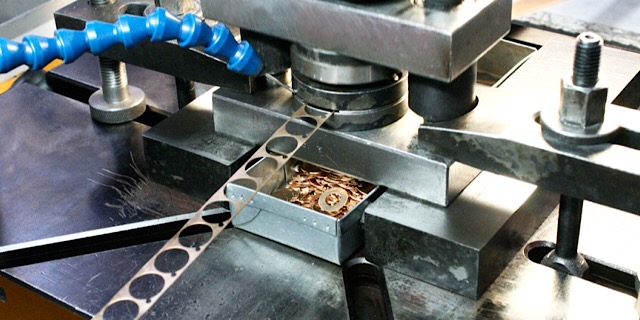Ultimate Overview to Metal Stamping Techniques and Applications
Ultimate Overview to Metal Stamping Techniques and Applications
Blog Article
Steel Marking Innovations: Elevating Production Processes for Superior Results
In the world of making procedures, steel marking has long been a cornerstone technique for producing an array of accuracy parts. With the unrelenting march of technical improvement, the landscape of steel marking is going through a substantial improvement.
Development of Metal Stamping Techniques

Furthermore, innovations in material science have caused the growth of high-strength alloys that can now be perfectly marked right into detailed forms, accommodating a wider series of commercial applications. The assimilation of robotics and expert system has actually further enhanced the stamping procedure by boosting speed and accuracy while minimizing the threat of human mistake.

Impact of Advanced Materials
Have advanced materials changed steel stamping processes substantially in the production market? The solution is a definite yes (Metal Stamping). The assimilation of innovative products has actually changed metal marking, allowing producers to attain greater accuracy, raised performance, and improved product top quality. By using materials such as high-strength alloys, progressed compounds, and cutting-edge coatings, metal stamping processes can now produce components that are lighter, more powerful, and a lot more durable than ever.
These innovative products supply superior mechanical properties, corrosion resistance, and thermal stability, enabling makers to fulfill the needs of modern industries such as aerospace, automobile, and electronics. Furthermore, using innovative materials in metal marking has actually promoted the manufacturing of intricate geometries and detailed layouts that were formerly unattainable via traditional methods.
Moreover, the application of sophisticated materials has led to reduced material waste, reduced manufacturing expenses, and shorter lead times, making metal marking procedures extra affordable and lasting. As technology continues to advance, the influence of innovative products on metal stamping processes is anticipated to drive more advancement and improve the competitiveness of makers in the worldwide market.
Automation in Steel Stamping
The evolution of steel stamping procedures driven by the assimilation of sophisticated materials has set the stage for significant developments in automation within the manufacturing sector. Automation in metal stamping has actually reinvented production procedures, boosting performance, precision, and total outcome high quality. Through the application of robotics, sensors, and computer-controlled systems, tasks that were once hand-operated and lengthy can currently be carried out with unmatched speed and precision.
Automation in metal marking not only increases manufacturing rates but likewise guarantees uniformity in the manufacturing procedure. By lessening human treatment, the danger of mistakes is considerably lowered, resulting in greater levels of item harmony and dependability. In addition, automation enables makers to undertake complicated marking tasks that would certainly be tough or unwise to accomplish manually.
Moreover, automation in steel stamping adds to a safer working environment by minimizing the need for workers to take part in repeated or hazardous jobs - Metal Stamping. This shift in the direction of automation not just boosts productivity however also leads the way for the future of production, where modern technology plays a main role in driving operational excellence
High Quality Control and Assessment Equipments
With a concentrate on accuracy and integrity, top quality control and inspection systems play an important function in guaranteeing product quality in steel marking procedures. These systems are created to check every phase of manufacturing, from product examination to the end product, to assure that all site here parts fulfill the called for criteria. By applying innovative modern technologies such as optical inspection systems, coordinate gauging equipments (CMM), and automated determining tools, suppliers can identify also the tiniest inconsistencies in measurements, surface area quality, and total honesty of stamped parts.

Sustainability Practices in Steel Stamping
Structure upon the foundation of precision and reliability developed through top quality control and assessment systems, the combination of sustainable practices in steel stamping procedures is significantly coming to be a focal point for makers seeking to reduce ecological impact and maximize source utilization. Sustainability techniques in metal stamping incorporate a series of efforts aimed at reducing waste generation, power usage, and greenhouse gas emissions throughout the production procedure.
One key facet of sustainability in metal marking is the fostering of environmentally friendly products and innovations that promote recyclability and waste decrease. By using recycled products and executing energy-efficient equipment, makers can decrease their carbon impact and contribute to a much more lasting production cycle. In addition, enhancing production processes to decrease material waste and power usage not just benefits the atmosphere but likewise leads to try this web-site set you back financial savings for services over time.
In addition, the application of lasting practices in steel stamping can improve brand name reputation and interest environmentally mindful customers. As sustainability remains to get significance in the production industry, incorporating environmentally friendly campaigns into steel marking processes is crucial for lasting success and competition on the market.
Verdict
In verdict, steel marking methods have actually dramatically view it progressed gradually, including advanced products and automation to enhance manufacturing procedures. Quality control and examination systems play a crucial role in making certain exceptional results, while sustainability techniques are progressively being implemented to decrease environmental influence. These technologies in steel marking have changed the market, causing much more effective and sustainable production approaches for various sectors.
Metal stamping, when a manual and labor-intensive procedure, has transformed right into a very automated and innovative method of forming metal sheets into numerous types and styles.Have sophisticated materials changed steel marking processes significantly in the production industry? By making use of materials such as high-strength alloys, advanced compounds, and innovative coverings, metal marking procedures can currently produce parts that are lighter, more powerful, and much more resilient than ever before.
The development of metal stamping procedures driven by the integration of innovative materials has established the phase for considerable developments in automation within the production market.In conclusion, metal stamping techniques have substantially progressed over time, integrating sophisticated products and automation to enhance producing procedures.
Report this page